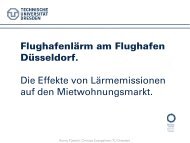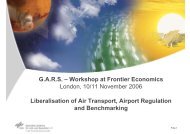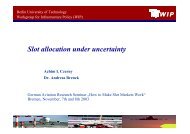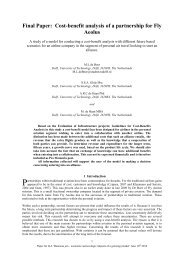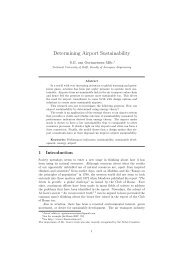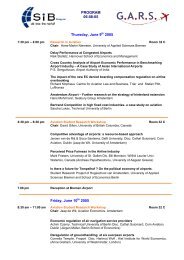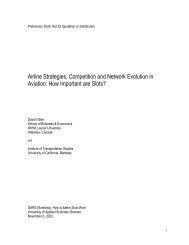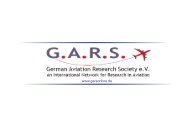Presentation
Presentation
Presentation
You also want an ePaper? Increase the reach of your titles
YUMPU automatically turns print PDFs into web optimized ePapers that Google loves.
Different Airport Pricing Regimes and<br />
Their Implications for Overall Welfare<br />
Master Thesis<br />
Annika Reinhold<br />
STREEM
Structure<br />
• Weight Based Pricing<br />
• Airport Congestion Pricing<br />
• Analytical Model<br />
• Numerical Model<br />
• Conclusions
Weight Based Pricing<br />
• Mostly applied pricing regime<br />
• Complex charging structure at many airports<br />
• Economic rationale<br />
– Adequate capacity, cover costs, rate of return<br />
– Ramsey pricing<br />
• Criticism<br />
– Application to congested airports<br />
– Under-pricing of facilities<br />
– Over-investment in capacity
(Airport) Congestion Pricing<br />
• Bottleneck situation<br />
– Rationing scarce resources<br />
– Users pay for caused congestion<br />
– Incentives for investment in capacity<br />
• Difficult to calculate marginal costs<br />
• Opposition to congestion tolls
Airport Congestion Pricing<br />
• Theoretical Models<br />
– Queuing bottleneck model<br />
– Internalization of congestion costs<br />
– Effect of market power<br />
– Hub and spoke networks
Airport Congestion Pricing<br />
• Application<br />
– Boston Logan Airport (BOS)<br />
– New York Airports (JFK, LGA, EWR, TEB)<br />
– London (LHR)
Analytical Model<br />
• Assumptions<br />
– 2 airlines<br />
– 1 airport<br />
• Inverse demand function<br />
D<br />
• Average cost function<br />
ci fi<br />
vi<br />
q<br />
1<br />
q<br />
1<br />
q<br />
q<br />
2<br />
2
Analytical Model<br />
First best toll<br />
• Airline profit maximisation<br />
– Fully symmetric setting<br />
– Nash equilibrium output (closed form)<br />
q N<br />
i<br />
• Airport welfare maximisation<br />
max<br />
• Optimal toll<br />
q<br />
i<br />
*<br />
0<br />
q<br />
1<br />
3<br />
1<br />
q<br />
2<br />
(<br />
*<br />
i<br />
v<br />
i<br />
f<br />
x)<br />
dx<br />
q<br />
i<br />
v<br />
q<br />
i<br />
q<br />
f<br />
i<br />
i<br />
v<br />
i<br />
q<br />
1<br />
q<br />
2
Analytical Model<br />
Second best toll<br />
• Maximise welfare subject to constraint<br />
w<br />
• Lagrangian multiplier<br />
i<br />
• Weight based toll<br />
i<br />
0<br />
q<br />
1<br />
q<br />
2<br />
(<br />
2<br />
q<br />
qi<br />
v i q<br />
( 2 vi<br />
v i )<br />
w<br />
i<br />
x)<br />
dx<br />
i<br />
q<br />
i<br />
q<br />
i<br />
f<br />
w<br />
i<br />
f<br />
i<br />
2<br />
v<br />
(<br />
(<br />
v<br />
2<br />
i<br />
v<br />
i<br />
q<br />
1<br />
q<br />
i<br />
q2<br />
2 v<br />
1<br />
2 v<br />
1<br />
1<br />
q<br />
v<br />
2<br />
i<br />
q1<br />
v )<br />
v<br />
2<br />
2<br />
)<br />
q<br />
i<br />
v<br />
(<br />
(<br />
1<br />
w<br />
q1<br />
2 v<br />
1<br />
2 v<br />
2<br />
2<br />
q<br />
v<br />
v<br />
2<br />
1<br />
1<br />
)<br />
)
Numerical Model<br />
Parameters<br />
Demand characteristics Airline cost function parameters<br />
α 200000 f 15000<br />
β 1 v 5000<br />
Ratio: average cost/ marginal cost 0,70<br />
Ratio: mr/mc 1,00<br />
Ratio: equilibrium fare/ average cost 1,86<br />
Ratio: equilibrium fare/ marginal cost 1,30<br />
Ratio: profits/ turnover 0,23<br />
Ratio: profits/ total costs 0,43<br />
Ratio: cong costs/ average costs 0,05<br />
Ratio: cong costs/ marginal costs 0,03<br />
Ratio: cong costs/ total costs 0,05<br />
Demand elasticity in equilibrium - 1,4
Numerical Model<br />
Base case<br />
• A319 and CRJ900<br />
• Calculating aircraft weights<br />
• Outcome<br />
First best Weight based<br />
Output airline 1 9.25 7.59<br />
Output airline 2 9.25 12.00<br />
Total 18.50 19.59<br />
Toll airline 1 46,236.1 49,994.1<br />
Toll airline 2 46,236.1 26,923.9<br />
Welfare level 1,711,078.9 1,704,991.0
Numerical Model<br />
Asymmetry in cost parameters<br />
1 2 3 4 5<br />
f_1 13000 f_1 13000 f_1 10000 f_1 10000 f_1 9000<br />
f_2 15000 f_2 18000 f_2 20000 f_2 20000 f_2 22000<br />
v_1 5000 v_1 5000 v_1 4500 v_1 4500 v_1 4000<br />
v_2 6000 v_2 6000 v_2 6500 v_2 6500 v_2 6500<br />
• Increasing asymmetry in cost parameters (1,2,3)<br />
• Increasing difference in aircraft weight (4,5)<br />
• In the end, only airline 1 stays in the market
Numerical Model<br />
Asymmetry in cost parameters<br />
welfare level<br />
3.000.000,00<br />
2.500.000,00<br />
2.000.000,00<br />
1.500.000,00<br />
1.000.000,00<br />
500.000,00<br />
-<br />
1 2 3 4 5<br />
scenarios<br />
τ*_2<br />
ω*<br />
ω_w<br />
τ_w2<br />
τ*_1<br />
τ_w1<br />
120.000,00<br />
100.000,00<br />
80.000,00<br />
60.000,00<br />
40.000,00<br />
20.000,00<br />
-<br />
-20.000,00<br />
-40.000,00<br />
toll level
Numerical Model<br />
Increasing congestion<br />
1 2 3 4<br />
f_1 15000 f_1 15000 f_1 10000 f_1 10000<br />
f_2 15000 f_2 15000 f_2 20000 f_2 20000<br />
v_1 5000 v_1 6000 v_1 6000 v_1 7000<br />
v_2 5000 v_2 6000 v_2 10000 v_2 12000<br />
• Identical parameters (1,2)<br />
• Introducing asymmetry (3,4)
Numerical Model<br />
Increasing congestion<br />
welfare level<br />
1.800.000,00<br />
1.600.000,00<br />
1.400.000,00<br />
1.200.000,00<br />
1.000.000,00<br />
800.000,00<br />
600.000,00<br />
400.000,00<br />
200.000,00<br />
-<br />
1 2 3 4<br />
scenarios<br />
ω_w<br />
τ_w1<br />
τ_w2<br />
τ*_2<br />
ω*<br />
τ*_1<br />
120.000,00<br />
100.000,00<br />
80.000,00<br />
60.000,00<br />
40.000,00<br />
20.000,00<br />
-<br />
-20.000,00<br />
toll level
Conclusion<br />
• Weight based pricing assumed to be<br />
inefficient<br />
• Theoretical congestion pricing models take<br />
into account different characteristics<br />
apparent at airports<br />
• Derivation of simple analytical model<br />
• Test results in numerical model
Conclusion<br />
• Tolls under the different pricing regimes<br />
move in opposite direction<br />
• Under weight based pricing efficient airline<br />
1 pays more than inefficient airline 2<br />
• Weight based pricing leads to lower<br />
welfare level than first best pricing<br />
• Weight based tolls do not help in allocating<br />
scarce capacity
Thank you!



